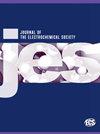在 CaCl2 熔体中电化学制备 Ti2CrV 合金
IF 3.3
4区 工程技术
Q2 ELECTROCHEMISTRY
引用次数: 0
摘要
Ti2CrV 合金在室温和环境压力下具有良好的储氢特性。本研究探讨了在 900 °C 的 CaCl2 熔体中通过 FFC 剑桥工艺将 TiO2-Cr2O3-V3O5 直接电化学还原为 Ti2CrV 的可行性。电解在烧结混合氧化物阴极和 HD 石墨阳极的双电极组件中进行,在 3.1 V 恒定电池电压下进行不同时间间隔的电解,以阐明金属氧化物混合物的还原机制。获得的产物通过 X 射线衍射、扫描电子显微镜和能量色散 X 射线光谱技术进行了表征。此外,还使用含有混合金属氧化物粉末的金属空腔电极进行了循环伏安研究,以确定在 900 °C 下 CaCl2 熔体中的电化学还原行为。研究发现,在氧化钛附近存在预成形的铬和钒金属有助于加快其还原速度。烧结的混合氧化物颗粒在电解 15 小时后完全金属化。据观察,电化学还原机制是通过各种中间产物进行的,如富铬 Cr-V、富钒 V-Cr、CaTiO3、TiO、Ti6O、Ti-V 和 C15-TiCr2。本文章由计算机程序翻译,如有差异,请以英文原文为准。
Electrochemical Preparation of Ti2CrV Alloy in CaCl2 Melt
Ti2CrV alloy shows good hydrogen storage characteristics at room temperature and ambient pressure. The present study investigated the feasibility of direct electrochemical reduction of TiO2-Cr2O3-V3O5 to Ti2CrV in CaCl2 melt at 900 °C by the FFC Cambridge process. The electrolysis was conducted in a two-electrode assembly with the sintered mixed oxide cathode and HD graphite anode at a constant cell voltage of 3.1 V for different time intervals to elucidate the reduction mechanism of the metal oxide mixture. The obtained products were characterized by X-ray diffraction, scanning electron microscopy, and energy-dispersive X-ray spectroscopy techniques. Cyclic voltammetry studies using metallic cavity electrode containing mixed metal oxide powder were also carried out to determine the electrochemical reduction behavior in CaCl2 melt at 900 °C. It was observed that the presence of pre-formed Cr and V metal in the vicinity of titanium oxide helped in its faster reduction. The complete metallization of the sintered mixed oxide pellet occurred after 15 h of electrolysis. The electrochemical reduction mechanism was observed to proceed through various intermediates such as chromium-rich Cr-V, vanadium-rich V-Cr, CaTiO3, TiO, Ti6O, Ti-V, and C15-TiCr2.
求助全文
通过发布文献求助,成功后即可免费获取论文全文。
去求助
来源期刊
CiteScore
7.20
自引率
12.80%
发文量
1369
审稿时长
1.5 months
期刊介绍:
The Journal of The Electrochemical Society (JES) is the leader in the field of solid-state and electrochemical science and technology. This peer-reviewed journal publishes an average of 450 pages of 70 articles each month. Articles are posted online, with a monthly paper edition following electronic publication. The ECS membership benefits package includes access to the electronic edition of this journal.

 求助内容:
求助内容: 应助结果提醒方式:
应助结果提醒方式:


